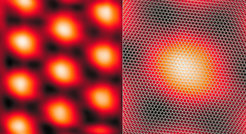New research highlights similarities in the insulating states of twisted bilayer graphene and cuprates
In recent decades, enormous research efforts have been expended on the exploration and explanation of high-temperature (high-Tc) superconductors, a class of materials exhibiting zero resistance at particularly high temperatures. Now a team of scientists from the United States, Germany and Japan explains in Nature how the electronic structure in twisted bilayer graphene influences the emergence of the insulating state in these systems, which is the precursor to superconductivity in high-Tc materials.

Finding a material which superconducts at room temperature would lead to a technological revolution, alleviate the energy crisis (as nowadays most energy is lost on the way from generation to usage) and boost computing performance to an entirely new level. However, despite the progress made in understanding these systems, a full theoretical description is still elusive, leaving our search for room temperature superconductivity mainly serendipitous.
In a major scientific breakthrough in 2018, twisted bilayer graphene (TBLG) was shown to exhibit phases of matter akin to those of a certain class of high-Tc superconducting materials – the so-called high-Tc cuprates.
The scientists from the Max Planck Institute for the Structure and Dynamics of Matter (MPSD), Freie Universität Berlin (both in Germany), Columbia University, the Center for Computational Quantum Physics at the Flatiron Institute (both in the USA) and the National Institute for Materials Science in Japan focused on the insulating state of TBLG.
This material is made up of two atomically thin layers of graphene, stacked at a very slight angle to each other. In this structure, the insulating state precedes the high- Tc superconducting phase. Hence, a better understanding of this phase and what leads up to it is crucial for the control of TBLG.
The scientists used scanning tunneling microscopy and spectroscopy (STM / STS) to investigate the samples. With this microscopic technique, electrically conducting surfaces can be examined atom by atom.
The findings, which have just been published in Nature, cast new light on the factors influencing the emergence of superconductivity in TBLG. The team observed that the insulating state, which precedes the superconducting state, appears at a particular level of filling the system with electrons. This enables scientists to estimate the strength and the nature of the interactions between electrons in these systems - a crucial step towards their description.
More information you can find here
